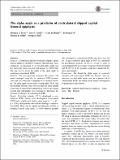| dc.contributor.author | Boyle, Matthew J. | en_US |
| dc.contributor.author | Lirola, Jose F. | en_US |
| dc.contributor.author | Hogue, Grant D. | en_US |
| dc.contributor.author | Yen, Yi-Meng | en_US |
| dc.contributor.author | Millis, Michael B. | en_US |
| dc.contributor.author | Kim, Young-Jo | en_US |
| dc.date.accessioned | 2016-08-09T14:54:53Z | |
| dc.date.issued | 2016 | en_US |
| dc.identifier.citation | Boyle, Matthew J., Jose F. Lirola, Grant D. Hogue, Yi-Meng Yen, Michael B. Millis, and Young-Jo Kim. 2016. “The alpha angle as a predictor of contralateral slipped capital femoral epiphysis.” Journal of Children's Orthopaedics 10 (3): 201-207. doi:10.1007/s11832-016-0732-x. http://dx.doi.org/10.1007/s11832-016-0732-x. | en |
| dc.identifier.issn | 1863-2521 | en |
| dc.identifier.uri | http://nrs.harvard.edu/urn-3:HUL.InstRepos:27822390 | |
| dc.description.abstract | Purpose Contralateral hip involvement in slipped capital femoral epiphysis (SCFE) is common. Femoral head−neck asphericity, as measured by an elevated alpha angle, has not previously been assessed with respect to SCFE risk. Our aim was to assess the utility of the alpha angle in predicting contralateral SCFE. Methods: We retrospectively reviewed 168 patients (94 males) managed surgically for unilateral SCFE between 2001 and 2013 who had a minimum of 18 months follow-up. The alpha angle, the posterior sloping angle (PSA), and the modified Oxford score were recorded for every patient at the time of initial SCFE presentation. Follow-up clinical records and radiographs were assessed to determine the presence of absence of contralateral SCFE. Results: Forty-five patients (27 %) developed a contralateral SCFE. Patients who developed a contralateral SCFE had a significantly higher alpha angle (51° vs 45°, p < 0.001) than patients who did not develop a contralateral SCFE. There was no significant difference in PSA or modified Oxford score (both p > 0.10) between patients who developed a contralateral SCFE and those who did not. Using a proposed alpha angle of 50.5° as a threshold for prophylactic fixation, 26 (58 %) of the 45 cases of contralateral SCFE in our study would have been prevented and 18 (15 %) of 123 patients would have undergone fixation unnecessarily. Conclusions: We found the alpha angle to positively correlate with contralateral SCFE risk. Patients with significantly elevated alpha angles may be at greater risk of contralateral SCFE and benefit from further investigation or prophylactic hip fixation. | en |
| dc.language.iso | en_US | en |
| dc.publisher | Springer Berlin Heidelberg | en |
| dc.relation.isversionof | doi:10.1007/s11832-016-0732-x | en |
| dc.relation.hasversion | http://www.ncbi.nlm.nih.gov/pmc/articles/PMC4909647/pdf/ | en |
| dash.license | LAA | en_US |
| dc.subject | Slipped capital femoral epiphysis | en |
| dc.subject | Alpha angle | en |
| dc.subject | Hip | en |
| dc.subject | Fixation | en |
| dc.title | The alpha angle as a predictor of contralateral slipped capital femoral epiphysis | en |
| dc.type | Journal Article | en_US |
| dc.description.version | Version of Record | en |
| dc.relation.journal | Journal of Children's Orthopaedics | en |
| dash.depositing.author | Yen, Yi-Meng | en_US |
| dc.date.available | 2016-08-09T14:54:53Z | |
| dc.identifier.doi | 10.1007/s11832-016-0732-x | * |
| dash.contributor.affiliated | Millis, Michael | |
| dash.contributor.affiliated | Yen, Yi-Meng | |
| dash.contributor.affiliated | Kim, Young-Jo | |


